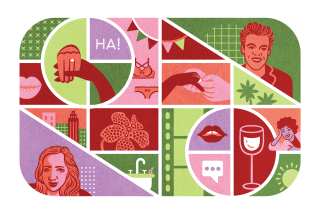Between the Rock and a Hard Place
- Share via
What is my budget?
What size diamond do I want?
What is more important to me, size or quality?
What cut do I prefer?
Attention, male shoppers:
Before you even think of plunking down two or three months’ salary to buy your fiancee the emerald-cut-set-in-platinum diamond engagement ring that spoke to her from Modern Bride magazine, sit down and work through the above questions. This is no time to be romantic.
Diamond engagement rings are still the tradition, and young men still like to present them as a surprise, says Faddoul Biada, a downtown Los Angeles jeweler and gemologist.
During the 32 years he’s been in the business, little has changed, he says. “Young brides look through magazines and line up the gown and bridesmaid dresses, but they don’t know anything about the quality of a ring. The bridegroom is stuck with this decision.”
And ill-equipped he is, in most cases, to make a big-ticket purchase that’s going to be scrutinized forever.
“It’s easy to lose your perspective in the emotion of the moment, but this is going to cost a lot of money, and you need to be a savvy consumer--cautious and alert,” emphasizes Pastor Herrera Jr., director of the Los Angeles County Consumer Affairs Department, realizing his advice is probably futile. “I don’t think men are apt to spend an extended period of time in contemplating a purchase.”
Furthermore, it’s easy to be intimidated by the hushed elegance of many jewelry stores. At least when buying a car you can kick the tires.
But, experts warn, that doesn’t mean you should resort to wandering through the jewelry mart or consulting your best friend’s uncle who is “in the business.”
And be wary of cable shopping channels, 1-800 pitches and unscrupulous Web sites.
“You should not rush out and buy an engagement ring. People get caught up in the romantic element and go into the store blind,” says Danna Spirer, a Los Angeles gemologist who has just produced a video guide to buying a diamond.
“What you need is a good, reputable jeweler and some basic shopping information,” she says.
Probably the essence of both is Tiffany & Co. “We represent tradition,” says Nellie Seddigh, director of the Beverly Hills store.
In fact, the store is so associated with diamond rings that many proposals have been made right there in the aisles, she says. “I am happy to say that romance is not dead.”
What’s so special about a diamond?
A diamond is pure, or nearly pure, carbon with special qualities including unique powers of light reflection that provide its brilliance.
“It’s the only gem composed entirely of one single element, and it is also the hardest transparent substance known,” Seddigh says.
Once you recognize the appeal, then you need to understand the tangibles that make each diamond different. These are the four Cs, Seddigh says:
* Cut, which determines the brilliance of a diamond.
* Clarity, meaning the diamond has few “inclusions,” trade language for blemishes.
* Color, which is rated on a scale from D to Z, with D being colorless and Z being an undesirable yellow or brown. The more colorless the diamond, the greater its rarity and value. (Fancy colored diamonds are in a separate class.)
* Carat weight, which is the gemologist’s standard measure of a diamond’s size.
Because the market has been saturated with fake diamonds over the last few years, she says, Tiffany’s now offers shoppers a video and a brochure on “How to Buy a Diamond” that explain all these categories. “We’re glad to mail it to anyone who requests it,” she says. And the store has scheduled a bridal showcase at 6:30 p.m. Feb. 23 covering all aspects of a wedding, including, of course, diamonds. (For information, call Heather Koenig at [310] 273-8880.)
An even more inclusive guide is offered by Spirer. With her brother, documentary filmmaker Peter Spirer, she has produced “All That Glitters: the Complete Video Guide to Buying a Diamond.” “I am trying to teach people how to get a great diamond and not get ripped off,” says Danna Spirer, who is certified by the Gemological Institute of America. “I was inspired to make this video because I was working in a jewelry store in Miami, Fla., and became aware I was selling inferior diamonds.”
Not only does she explain the four Cs, the kit also includes how diamonds are priced, the fact that round cuts retain their value more than fancy cuts, and the fact that jewelers are required by law to reveal if a diamond is treated or enhanced.
In addition to the 30-minute video, the kit includes a loupe “so that people can practice at home and learn how to scrutinize a stone,” Spirer says. “There are too many variations. Maybe you want to sacrifice clarity for cut and color.”
At the Gemological Institute of America, a nonprofit research and education service based in Carlsbad, spokeswoman Victoria Morrison echoes the advice to find a jeweler you feel comfortable with and learn your four Cs.
“And if you want the ultimate peace of mind, ask your jeweler to have the diamond graded by the GIA,” she says. “A diamond grading report will tell you everything you want to know or not know about your purchase.”
To order “All that Glitters: The Complete Video Guide to Buying a Diamond,” call (888) 345-GEMS.






